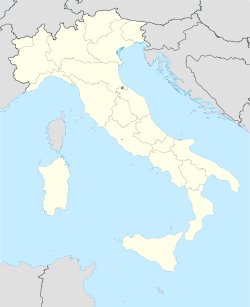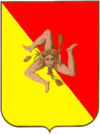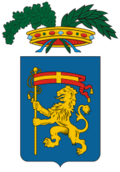Taormina
| Comune di Taormina | |
|---|---|
 |
|
 |
|
| Country | |
| Region | Sicily |
| Province | Messina (ME) |
| Mayor | Carmelantonio D'Agostino Elected:2006-06-11 Centre-right (Liste Civiche) |
| Elevation | 204 m (669 ft) |
| Area | 13 km² (5 sq mi) |
| Population (as of 2007) | |
| - Total | 10,991 |
| - Density | 845/km² (2,189/sq mi) |
| Time zone | CET, UTC+1 |
| Coordinates | |
| Gentilic | Taorminesi |
| Dialing code | 0942 |
| Postal code | 98039 |
| Frazioni | Mazzeo, Trappitello, Villagonia |
| Patron | San Pancrazio di Taormina |
| - Day | 9 July |
| Website: www.comune.taormina.me.it | |
Taormina (Sicilian: Taurmina; Greek: Ταυρομένιον - Tauromenion; Latin Tauromenium) is a comune and small town on the east coast of the island of Sicily, Italy, in the Province of Messina, about midway between Messina and Catania. Taormina has been a very popular tourist destination since the 19th century. It has popular beaches (accessible via an aerial tramway) on the Ionian sea, which is remarkably warm and has a high salt content. Taormina can be reached via highways (autostrade) from Messina from the north and Catania from the south.
Contents |
History
Ancient
According to ??? Taormina's area was inhabited the Siculi even before the Greeks arrived on the Sicilian coast in 832 BC to found a town called Naxos. His theory that Tauromenion was founded by colonists from Naxos is confirmed by Strabo and other ancient writers.
The new settlement seems to have risen rapidly to prosperity, and was apparently already a considerable town at the time of the expedition of Timoleon in 345 BC. It was the first place in Sicily where that leader landed, having eluded the vigilance of the Carthaginians, who were guarding the Straits of Messina, and crossed direct from Rhegium (modern Reggio di Calabria) to Tauromenium. (Diod. xvi. 68; Plut. Timol. 10.) The city was at that time still under the government of Andromachus, whose mild and equitable administration is said to have presented a strong contrast with that of the despots and tyrants of the other Sicilian cities. He welcomed Timoleon with open arms, and afforded him a secure resting place until he was enabled to carry out his plans in other parts of Sicily. (Diod. l. c.; Plut. l. c.) It is certain that Andromachus was not deprived of the chief power, when all the other tyrants were expelled by Timoleon, but was permitted to retain it undisturbed till his death. (Marcellin. Vit. Thucyd. § 27.) Little is known about Tauromenium for some time after this. It is probable that it passed under the authority of Agathocles, who drove the historian Timaeus into exile; and some time after this it was subject to a domestic despot of the name of Tyndarion, who was contemporary with Hicetas of Syracuse and Phintias of Agrigentum. (Diod. xxii. Exc. H. p. 495.) Tyndarion was one of those who concurred in inviting Pyrrhus into Sicily (278 BC), and when that monarch landed with his army at Tauromenium, joined him with all his forces, and supported him in his march upon Syracuse. (Diod. l. c. pp. 495, 496.) A few years later we find that Tauromenium had fallen into the power of Hieron of Syracuse, and was employed by him as a stronghold in the war against the Mamertines. (Id. p. 497.) It was also one of the cities which was left under his dominion by the treaty concluded with him by the Romans in 263 BC. (Diod. xxiii. p. 502.) This is doubtless the reason that its name is not again mentioned during the First Punic War.

There is no doubt that Tauromenium continued to form a part of the kingdom of Syracuse till the death of Hieron, and that it only passed under the government of Rome when the whole island of Sicily was reduced to a Roman province; but we have scarcely any account of the part it took during the Second Punic War, though it would appear, from a hint in Appian (Sic. 5), that it submitted to Marcellus on favorable terms; and it is probable that it was on that occasion it obtained the peculiarly favored position it enjoyed under the Roman dominion. For we learn from Cicero that Tauromenium was one of the three cities in Sicily which enjoyed the privileges of a civitas foederata or allied city, thus retaining a nominal independence, and was not even subject, like Messana, to the obligation of furnishing ships of war when called upon. (Cic. Verr. ii. 6. 6, iii. 6, v. 19.) But the city suffered severe calamities during the Servile War in Sicily, 134-132 BC, having fallen into the hands of the insurgent slaves, who, on account of the great strength of its position, made it one of their chief posts, and were able for a long time to defy the arms of the consul Rupilius. They held out until they were reduced to the most fearful extremities by famine, when the citadel was at length betrayed into the hands of the consul by one of their leaders named Sarapion, and the whole of the survivors put to the sword. (Diod. xxxiv. Exc. Phot. p. 528; Oros. v. 9.) Tauromenium again bore a conspicuous part during the wars of Sextus Pompeius in Sicily, and, from its strength as a fortress, was one of the principal points of the position which he took up in 36 BC, for defence against Octavian. It became the scene also of a sea-fight between a part of the fleet of Octavian, commanded by the triumvir in person, and that of Pompeius, which terminated in the defeat and almost total destruction of the former. (Appian, B.C. v. 103, 105, 106-11, 116; Dion Cass. xlix. 5.) In the settlement of Sicily after the defeat of Pompey, Tauromenium was one of the places selected by Augustus to receive a Roman colony, probably as a measure of precaution, on account of the strength of its situation, as we are told that he expelled the former inhabitants to make room for his new colonists. (Diod, xvi. 7.) Strabo speaks of it as one of the cities on the east coast of Sicily that was still subsisting in his time, though inferior in population both to Messana and Catana. (Strab. vi. pp. 267, 268.) Both Pliny and Ptolemy assign it the rank of a colonia (Plin. iii. 8. s. 14; Ptol. iii. 4. § 9), and it seems to have been one of the few cities of Sicily that continued under the Roman Empire to be a place of some consideration. Its territory was noted for the excellence of its wine (Plin. xiv. 6. s. 8), and produced also a kind of marble which seems to have been highly valued. (Athen. v. p. 207.) Juvenal also speaks of the sea off its rocky coast as producing the choicest mullets. (Juv. v. 93.) The Itineraries place Tauromenium 32 miles from Messana, and the same distance from Catana. (Itin. Ant. p. 90; Tab. Peut.)
Middle Ages and Modern Era
It continued after the fall of the Roman Empire to be one of the more considerable towns of Sicily, and from the strength of its position was one of the last places that was retained by the Greek emperors; but it was taken by the Arabs in 902 after a siege of two years, and totally destroyed. Name of her was renamed as "Al-Muizzia" in honour of Imam al-Muizz, who was a Fatimid Caliph. Muslim rule of the town (see History of Islam in southern Italy) lasted to 1078, when it was captured by the Norman lord Roger I.
After the fall of the Normans and of their heirs, the Hohenstaufen, Taormina followed the history of Sicily under the Angevines and then the Aragonese. In 1410 King Martin II of Sicily was elected here by the Sicilian Parliament. Later Taormina was under Spanish suzerainty, receiving the title of City in the 17th century.
In 1675 it was besieged by the French, who had occupied Messina. Under the Bourbons dynasty of the Kingdom of Two Sicilies, Taormina had not a relevant role; it anyway obtained an easiest access when part of the Catrabico promontory was partially cut and a seaside read connecting it to Messina and Catania was created. It received also a station on the second oldest railroad in the reign. Starting from the 19th century Taormina became a popular tourist resort in the whole Europe: people who spent vacation in Taormina include Oscar Wilde, Nicholas I of Russia, Johann Wolfgang von Goethe, Nietzsche (who here wrote his Also sprach Zarathustra), Richard Wagner and many others.
Contemporary history
In the late 19th century Taormina gained further prominence as the place where Wilhelm von Gloeden worked most of his life as a photographer of predominantly male nudes. Also credited for making Taormina popular was Otto Geleng, best known in his hometown of Berlin for his fine paintings, which he composed and painted in Italy but exhibited in Germany. What distinguishes Geleng, however, is his choice to depict the more southern regions where he captured the spectacular views and light of Sicily. He often painted the area's Greek colonial ruins, including Taormina.Taormina's first important tourist was Johann Wolfgang Goethe who dedicated exalting pages to the city in his book entitled "Journey to Italy," but perhaps it was Geleng’s views that made its beauty talked about throughout Europe and turned the site into a famous tourist center. The artist arrived in Sicily at the age of 20 in search of new subjects for his paintings. On his way through Taormina he was so enamoured by the landscape that he decided to stop for part of the winter. Geleng began to paint everything that Taormina offered: ruins, sea, mountains, none of which were familiar to the rest of Europe. When his paintings were later exhibited in Berlin and Paris, many critics accused Geleng of having an ‘unbridled imagination’. At that, Geleng challenged them all to go to Taormina with him, promising that he would pay everyone's expenses if he were not telling the truth.
During the early 20th century the town became a colony of expatriate artists, writers, and intellectuals. D. H. Lawrence stayed here at the Fontana Vecchia from 1920 to 1922, and wrote a number of his poems, novels, short stories, and essays, and a travel book, Sea and Sardinia. Charles Webster Leadbeater, the theosophical author, found out that Taormina had the right magnetics fields for Jiddu Krishnamurti to develop his talents, so the young Krishnamurti dwelt here from time to time. Halldór Laxness, the Icelandic author, worked here on the first modern Icelandic novel, Vefarinn mikli frá Kasmír.
By this time Taormina had become "a polite synonym for Sodom" as Harold Acton described it. Later, however, after the Second World War Acton was visiting Taormina with Evelyn Waugh and, coming upon a board advertising “Ye Olde English Teas” he sighed and commented that Taormina 'was now quite as boring as Bournemouth'.

Main sights

Archaeology
The present town of Taormina occupies the ancient site, on a lofty hill which forms the last projecting point of the mountain ridge that extends along the coast from Cape Pelorus to this point. The site of the old town is about 300 m above the sea, while a very steep and almost isolated rock, crowned by a Saracen castle, rises about 150 m higher: this is undoubtedly the site of the ancient Arx or citadel, the inaccessible position of which is repeatedly alluded to by ancient writers. Portions of the ancient walls may be traced at intervals all round the brow of the hill, the whole of the summit of which was evidently occupied by the ancient city. Numerous fragments of ancient buildings are scattered over its whole surface, including extensive reservoirs of water, sepulchres, tesselated pavements, etc., and the remains of a spacious edifice, commonly called a Naumachia, but the real destination of which it is difficult to determine. But by far the most remarkable monument remaining at Taormina is the ancient theatre (the teatro greco, or "Greek theatre"), which is one of the most celebrated ruins in Sicily, on account both of its remarkable preservation and of the surpassing beauty of its situation. It is built for the most part of brick, and is therefore probably of Roman date, though the plan and arrangement are in accordance with those of Greek, rather than Roman, theatres; whence it is supposed that the present structure was rebuilt upon the foundations of an older theatre of the Greek period. With a diameter of 109 metres (after an expansion in the 2nd century), this theatre is the second largest of its kind in Sicily (after that of Syracuse); it is frequently used for operatic and theatrical performances and for concerts. The greater part of the original seats have disappeared, but the wall which surrounded the whole cavea is preserved, and the proscenium with the back wall of the scena and its appendages, of which only traces remain in most ancient theatres, are here preserved in singular integrity, and contribute much to the picturesque effect, as well as to the interest, of the ruin. From the fragments of architectural decorations still extant we learn that it was of the Corinthian order, and richly ornamented. Some portions of a temple are also visible, converted into the church of San Pancrazio, but the edifice is of small size.
Others
- The Duomo (Cathedral), dating from the 13th century
- Palazzo Corvaja (10th century)
- Baroque fountain (1635)
- Church of San Domenico
In March 2004, the wife of the Anglican Rector in Taormina - yes, there's a small flock there to be tended - related the following story: In 1943 the Allies bombed Taormina on San Pancrazio's Feast Day (July 9) during the celebratory procession. After that, the story goes, Pancrazio was completely discredited as the town's patron. The townfolk having concluded that his "Patronage" was obviously ineffective.
Culture and tourism
Just south of Taormina is the Isola Bella, a nature reserve. Tours of the Capo Sant' Andrea grottos are also available. Taormina is built on an extremely hilly coast, and is approximately a forty-five minute drive away from Europe's largest active volcano, Mount Etna.
In 1927 the young Icelandic writer Halldór Laxness (born 1902) published his first major novel, Vefarinn mikli frá Kasmír (The Great Weaver of Kashmir), a panorama of social, literary, religious and sexual issues of his times. Laxness, who won the Nobel prize for literature in 1955, wrote most of his novel in Taormina which he then praised highly in his book of autobiographical essays, Skáldatími (The Time of the Poet) from 1963.
Between 1948 and 1999 the English writer Daphne Phelps lived in the Casa Cuseni designed and built by Robert Hawthorn Kitson in 1905, and entertained various friends including Bertrand Russell, Roald Dahl, and Tennessee Williams.
Events
Many manifestations and events are organized during the summer in Taormina. The exceptional frame for pop and classical concerts, opera and important performances often recorded by television (for example, the ceremony of the Silver Ribbon Award, the Festivalbar, the Kore) is the Ancient Theatre. Since 1983, the most important performances, are realized by Taormina Arte, the cultural institution which organizes one of the most famous music, theatre and dance festivals. Inside the program of Taormina Arte there is the Taormina Film Fest, the well-known cinema festival, the heir of the Cinema Festival of Messina and Taormina, born in 1960, which for about twenty years has guessed the David of Donatello Awards with the participations of the most famous Italian film stars. During the Taormina Film Fest now are awarded the Silver Ribbons, prize created by the Italian Film Journalists.
Since 2005, in October, Taormina Arte has been organizing the Giuseppe Sinopoli Festival, a festival dedicates completely to the great conductor, died in 2001, for many years the artistic director of Taormina Arte.
See also
- European archaeology
Image gallery
External links
- Official website of the Comune of Taormina
- Taormina on Best of Sicily
- Taormina Arte official website
- Taormina Film Fest website
- Taormina travel guide from Wikitravel
References
- This article incorporates text from the public domain Dictionary of Greek and Roman Geography by William Smith (1856).
|
|||||||||

